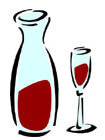Nothing causes more fear, hesitation and deep thought than the challenge of pairing food with wine. The simple answer: don’t think so much. First learn a few simple concepts and then let your imagination introduce you to new tastes and sensations. Pairing should be initially approached with common sense. Start off simple but never be afraid to experiment.
 Foods have different weights in terms of taste. A sirloin steak is heavier than a boiled shrimp. The weight is determined by factors like fat content and method of cooking. A steak cooked over an open fire will taste heavier than a steak fried in a pan. Likewise wines have weights as well. A wine made from Cabernet Sauvignon is heavier than wine made from Pinot Noir. Thus when eating a barbecued steak the Cabernet Sauvignon will probably be the better choice.
Foods have different weights in terms of taste. A sirloin steak is heavier than a boiled shrimp. The weight is determined by factors like fat content and method of cooking. A steak cooked over an open fire will taste heavier than a steak fried in a pan. Likewise wines have weights as well. A wine made from Cabernet Sauvignon is heavier than wine made from Pinot Noir. Thus when eating a barbecued steak the Cabernet Sauvignon will probably be the better choice.
The old rule of white with fish and red with meat is being continually tested in modern cooking. Grilled salmon is frequently served with Pinot Noir as are tuna and swordfish. There are even those who swear by sushi and Burgundy but surely that is for advanced palates. Often the fat of heavier foods will tone down the high tannins found in the heavier wines, thus providing a pleasant combination.
Sugar content is another consideration. For a dish high in sugar it’s usually better to serve a slightly sweet wine. This is why German Riesling, which is often somewhat sweet or off-dry, does so well with the sweeter Asian cuisine. Actually German Riesling does well with anything on the sugary side. A classic dish to serve it with is pork chops and apple sauce. The rule of thumb when serving sweet foods is to never serve a wine with less sugar than the food. This prevents the food from obscuring the wine with cloying sugars.
How much acid the food contains should always be kept in mind. Sautéed shrimp in lemon butter has a lot of acidity and so the wine should also contain enough acidity to match the food. Wines like Sauvignon Blanc or Pinot Grigio will always perform well in high acid situations.
There are some foods that plain don’t go with wine. Any vinegar with the exception of aged balsamic will kill a wine on contact. Artichokes are perhaps the greatest challenge for pairing. They have the ability to make any wine taste metallic and really should be avoided, perhaps a high acid white can make a passable match but it’s really more of a compromise than a pairing.
Again, no absolutes exist in the world of food and wine. Once the basics are mastered a whole spectrum of taste awaits. Many of the greatest pairings happen by accident, though you will find yourself going back to certain combinations, like Cabernet Sauvignon and beef or Bordeaux and lamb, again and again. Some things probably shouldn’t be tampered but never be afraid to try. A magical thing can happen when the sum of two parts somehow becomes greater than the whole. Wine has the ability to unlock flavors you never thought existed just as food has the power to turn an everyday un-exciting wine into a lip-smacking good drink.